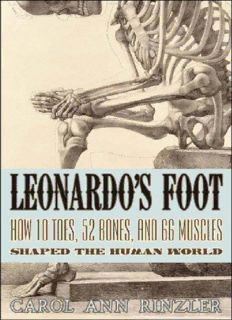
Leonardo's Foot: How 10 Toes, 52 Bones, and 66 Muscles Shaped the Human World PDF
Preview Leonardo's Foot: How 10 Toes, 52 Bones, and 66 Muscles Shaped the Human World
LEONARDO’S FOOT HOW 10 TOES, 52 BONES, AND 66 MUSCLES SHAPED THE HUMAN WORLD LEONARDO’S FOOT HOW 10 TOES, 52 BONES, AND 66 MUSCLES SHAPED THE HUMAN WORLD CAROL ANN RINZLER BELLEVUE LITERARY PRESS New York First published in the United States in 2013 by Bellevue Literary Press, New York FOR INFORMATION CONTACT: Bellevue Literary Press NYU School of Medicine 550 First Avenue OBV A612 New York, NY 10016 Copyright © 2013 by Carol Ann Rinzler All rights reserved. No part of this publication may be reproduced or transmitted in any form or by any means, electronic or mechanical, including photocopy, recording, or any information storage and retrieval system now known or to be invented, without permission in writing from the publisher, except by a reviewer who wishes to quote brief passages in connection with a print, online, or broadcast review. Bellevue Literary Press would like to thank all its generous donors—individuals and foundations—for their support. Library of Congress Cataloging-in-Publication Data Rinzler, Carol Ann. Leonardo’s foot : how 10 toes, 52 bones, and 66 muscles shaped the human world / Carol Ann Rinzler. — 1st ed. p. ; cm. Includes bibliographical references and index. ISBN 978-1-934137-63-5 I. Title. [DNLM: 1. Anthropology, Physical—history—Popular Works. 2. Biological Evolution--Popular Works. 3. Foot—Popular Works. 4. History of Medicine—Popular Works. GN 50.4] QP34.5 612—dc23 2013004519 Book design and type formatting by Mulberry Tree Press, Inc. Manufactured in the United States of America First Edition 10 9 8 7 6 5 4 3 2 1 “The human foot is a masterpiece of engineering and a work of art.” Leonardo da Vinci, The Notebooks (c. 1508–1518) For Perry Luntz MARCH 9, 1927–APRIL 13, 2009 and Patricia Marie Dolan MAY 6, 1939–NOVEMBER 15, 2011 CONTENTS Illustrations Introduction 1 Destiny From there to here The anthropology of an upright posture Determining destiny The architecture of the biped body 2 Disability First impressions, catalogues, and curiosities Cruel and unusual cures Entering the genome 3 Difference Creating the curve The discriminating drama of the different foot Fixing or not fixing the no-problem problem Foot rules and rulers 4 Diet Naming, not taming, the beast Podiatric protein problems Power, prevention, and sexual prowess Gout’s white shoe fraternity Cutting corns and cultivating customers Safe, effective—and expensive 5 Desire The heart wants what the nose knows Do gods have feet? Uncovering what’s inside Objects of desire Building the perfect foot Appendix: Pais, ped, pod Sources and Bibliography Index ILLUSTRATIONS Koala hand with two thumbs vs. foot with one thumb. Vitruvian Man, Leonardo da Vinci, c. 1490. Human skull, Gray’s Anatomy, 1918. Ape and human spines, courtesy of Joe Gannon, Mulberry Tree Press, Inc. Ape and human dental arch, from Kimball’s Biology Pages, http://biology- pages.info. Frontispiece, Les Oeuvres de M. Ambroise Paré, 1585 Human Foot, Gray’s Anatomy, 1918. The Birth of Venus, Sandro Botticelli, 1486. In the Dance Studio, Edgar Degas, c. 1897. Footprint of the Buddha, c. 1st century. The great god Pan, A Dictionary of Classical Antiquities, Dr. Oskar Seyffert, 1902. Cartoon of Jews extracting Christian blood to be used in religious ritual, Der Sturmer, 1934. Map of Negro Foot, Hanover County, Virginia. U.S. Department of the Interior. Advertisement for Dr. Scholl’s “Foot-Eazer,” The Literary Digest, April 1912.
Description: